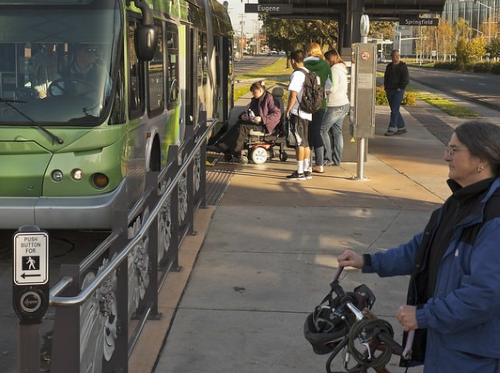Several state departments of transportation recently provided funds for a variety of mobility programs that aim to make it easier for people to walk, bike, share rides, and use transit services.
[Above photo by the Oregon DOT]
The Oregon Department of Transportation, for one, is seeking applications for its new Innovative Mobility Micro-Grants. The $5,000 grants are the first project to come forward from the $20 million Innovative Mobility Program, a new initiative created by the agency in March at the direction of the Oregon Transportation Commission.

The program has a special focus on equity and aiding historically excluded groups get to where they need to go more quickly, cheaply, and safely, the agency added.
“There’s a major transportation evolution happening across the country, and we have a chance to make sure that communities of color and other marginalized individuals who have been excluded in the past have place, purpose and priority in Oregon’s future transportation investments,” said Alando Simpson, vice chair of the Oregon Transportation Commission, in a statement.
“[This program] will combine new technologies and smarter partnerships to meet Oregon’s transportation needs in ways that are more equitable and climate-friendly than single-occupancy vehicles that run on fossil fuels,” Simpson added.

“Safe and equitable access to public and active transportation is critical for the one-third of Oregonians who don’t have a car, as well as those who choose not to drive,” said Karyn Criswell, Oregon DOT’s public transportation division administrator. “While we engage the community in designing the program, micro-grants are a way that folks can start accessing innovative mobility funds right now.”
Other state DOTs are involved in similar mobility support efforts.
The Massachusetts Department of Transportation awarded $5.5 million in grants to 16 communities in August as part of the first round of its fiscal year 2023 Complete Streets funding program.
Those grants help municipalities fund local multimodal infrastructure projects that improve travel for bicyclists, pedestrians, public transit users, and people using other forms of transportation. This is the 13th overall round of grants made by this program since Governor Charlie Baker (R) launched it back in 2016.
Similarly, the Minnesota Department of Transportation recently provided 13 cities and counties with consulting support as part of a $400,000 Planning Assistance contract to help create active transportation plans.
The agency said consultants analyze existing transportation conditions as part of this planning service, engage the community, then identify ways to improve infrastructure and encourage the use of active transportation. They provide monthly reports with the Minnesota DOT reviewing them to ensure they make progress on those plans.

“Providing these technical assistance opportunities offers communities the chance to envision and ultimately implement improvements that make active transportation safe and convenient for people in the places where they live, work and play,” said Nancy Daubenberger, Minnesota DOT’s commissioner, in a statement. “These also help reduce the amount of vehicle miles traveled and improve local transportation options.”
Meanwhile, the Washington State Department of Transportation recently finished a four-year revision of its Human Services Transportation Plan.
WSDOT collaborated with the Disability Mobility Initiative on this plan revision to incorporate the experiences of those who cannot drive and face barriers to transportation access that many may take for granted.
“It’s critical that everyone in our state has convenient access to reliable transportation, no matter their age, income, physical ability or where they live,” said Brian Lagerberg, WSDOT’s public transportation division director, in a statement. “This plan provides our partners with a blueprint for serving the people who need efficient and specialized transportation options the most.”
 Nation
Nation
Registration Open for AASHTO’s Winter Rail Meeting
December 19, 2025 Nation
Nation

